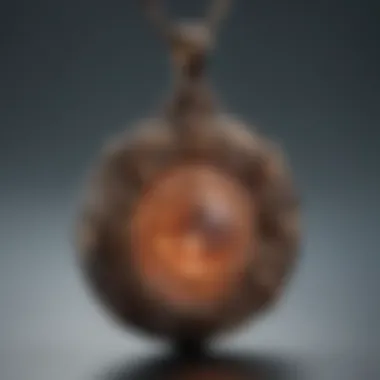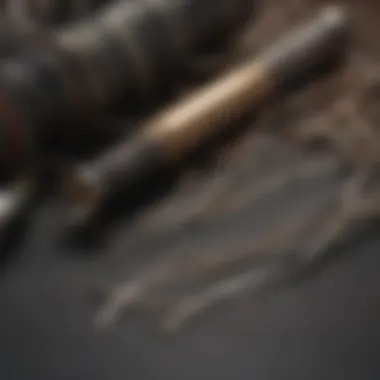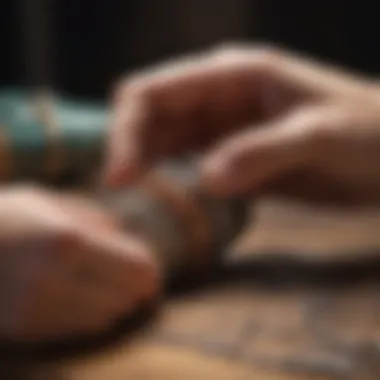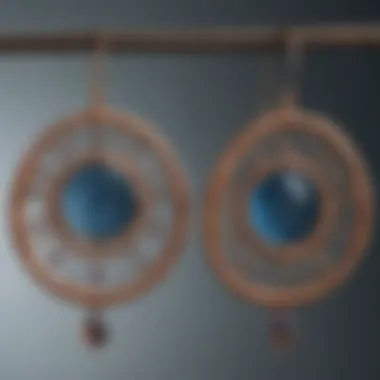Unveiling the Intricacies of Wire Wrapping: A Comprehensive Guide


Wire wrapping is a captivating technique utilized in crafting and jewelry making. It involves the meticulous process of shaping and securing wire around stones or beads to create unique and intricate pieces of jewelry. From the fundamental tools required to the advanced techniques employed, wire wrapping offers a creative outlet for artisans to express their artistic flair. In this comprehensive guide, we will delve into the world of wire wrapping, unraveling the secrets and nuances that define this art form.
Tools and Materials
Before embarking on a wire wrapping journey, one must familiarize themselves with the essential tools and materials. Precision is key in this craft, demanding tools such as pliers, wire cutters, and a mandrel for shaping. Additionally, the quality and type of wire used significantly influence the final outcome of the piece. Copper, silver, and gold wires each imbue distinct characteristics and aesthetics to the jewelry, providing a myriad of creative possibilities for the artist to explore.
Basic Techniques
To start mastering wire wrapping, beginners often begin with fundamental techniques such as creating loops, twists, and wraps. These techniques serve as the building blocks for intricate designs, allowing artists to experiment with different patterns and structures. Understanding the tensile strength of the wire and the appropriate gauges for various projects is crucial in achieving both stability and aesthetic appeal in the final piece.
Advanced Methods and Designs
As artisans progress in their wire wrapping journey, they may delve into more advanced methods and designs. From weaving and coiling to incorporating gemstones and crystals, the possibilities are truly endless. By integrating diverse techniques and materials, artists can push the boundaries of traditional wire wrapping, creating one-of-a-kind masterpieces that showcase their ingenuity and skill.
The Magic of Wire Wrapping
In essence, wire wrapping transcends mere jewelry making to become a form of artistry. The intricate manipulation of wire, combined with a deep understanding of design principles, culminates in pieces that not only adorn but also captivate the beholder. Whether crafting a simple pendant or an elaborate necklace, each wire-wrapped creation is imbued with a sense of creativity and dedication that reflects the artist's passion for their craft.
Introduction to Wire Wrapping
Wire wrapping, an intriguing art form in jewelry making, serves as a focal point in this comprehensive guide. This technique entails creating jewelry using various wires to craft intricate designs. Understanding the nuances of wire wrapping is essential for enthusiasts looking to master the art form. This section explores the fundamentals of wire wrapping and its significance in creating stunning jewelry pieces.
Understanding the Art of Wire Wrapping
History of Wire Wrapping
Delving into the history of wire wrapping unveils its deep-rooted origins and evolution over time. From ancient civilizations to modern artisans, the method has transcended eras, showcasing its timeless appeal. The history of wire wrapping serves as a testament to human creativity and innovation in jewelry crafting. Its versatility and durability make it a favored choice among craftsmen seeking to create enduring pieces.
Benefits of Wire Wrapping
The benefits of wire wrapping are manifold, ranging from creative freedom to structural integrity. This technique allows artisans to express their artistic vision through intricate designs and patterns. Additionally, wire wrapping ensures the longevity of jewelry pieces, as the wires provide stability and support to embellishments. Its flexibility and adaptability make it ideal for crafting diverse jewelry styles, appealing to a wide range of design preferences.


Tools and Materials
Essential Tools for Wire Wrapping
Embarking on a wire wrapping journey necessitates understanding the importance of essential tools. From round-nose pliers to wire cutters, each tool plays a crucial role in shaping and manipulating wires. These tools facilitate precision and accuracy in creating intricate designs, ensuring a seamless creative process.
Types of Wire Materials
Exploring the diverse types of wire materials opens up a world of possibilities for artisans. Copper, silver, and gold wires offer distinct characteristics that impact the final look of jewelry pieces. Understanding the properties of each wire type is paramount in achieving desired aesthetics and structural integrity. Dive into the realm of wire materials to elevate your wire wrapping creations.
Setting Up Your Workspace
Organizing Tools and Supplies
Efficiently organizing tools and supplies is essential for a seamless wire wrapping experience. A well-arranged workspace enhances productivity and reduces the likelihood of misplaced items, streamlining the creative process. By categorizing tools based on functionality and frequency of use, artisans can optimize their workspace for maximum efficiency.
Creating a Safe Working Environment
Prioritizing safety in the workspace is paramount when engaging in intricate wire wrapping techniques. Implementing safety measures such as wearing protective gear and ensuring proper ventilation fosters a secure working environment. By mitigating potential risks associated with wire manipulation, artisans can focus on honing their craft and bringing their creative visions to life.
Basic Wire Wrapping Techniques
Wire wrapping techniques are the backbone of creating exquisite wire-wrapped jewelry pieces. In this section, we delve into the fundamental skills required to master the art of wire wrapping. From the precision of crafting wire loops to the intricacy of coil designs, these techniques form the foundation on which creativity flourishes in jewelry making.
Simple Wire Wrapping Steps
Basic Wire Loop
The Basic Wire Loop is a fundamental element in wire wrapping, serving as a building block for various jewelry designs. Its simplicity belies its importance; the perfectly formed loop ensures secure attachment of beads and gemstones. This technique offers versatility in creating connections between intricate components, making it a popular choice among jewelry artisans. While its straightforward nature can be advantageous for beginners, its limitations lie in its size variability and potential for loosening over time, requiring extra care in securing the loops for lasting jewelry pieces.
Wire Coil


The Wire Coil technique adds texture and dimension to wire-wrapped jewelry, elevating designs with a spiral allure. Coils can be tight or loose, creating unique patterns that amplify the aesthetic appeal of the piece. This method is favored for its decorative charm and ability to fill empty spaces within a design, adding a sense of completion. However, managing the tension and spacing of coils can be challenging, demanding precision and practice to achieve desired results without distorting the overall look.
Bail Making
Crafting bails is crucial for attaching pendants and charms to chains or cords, providing a seamless connection that enhances wearability. Bails come in various styles, from simple loops to intricate designs, adding personality to the finished piece. The choice of bail design can impact the way a pendant hangs and interacts with the wearer, influencing the overall aesthetics of the jewelry. While bail making offers creative freedom and customization, ensuring structural integrity and proportionality is key to a successful piece.
Adding Beads and Stones
Adding beads and gemstones enriches wire-wrapped jewelry, infusing color and sparkle into the design. The incorporation of these elements not only enhances the visual appeal but also creates focal points that draw attention. Playing with different sizes and types of beads can alter the overall look, offering endless possibilities for creativity. However, securing beads and gemstones requires precision to prevent shifting or detachment, demanding attention to detail and meticulous execution to achieve a polished finish.
Creating Wire Frames
Wire frames provide structure and form to wire-wrapped jewelry pieces, shaping the foundation on which embellishments are added. Wire sculpting techniques allow artists to mold wire into intricate shapes, adding depth and character to the design. Constructing wire frames involves strategic bending and shaping of wire to create the desired outline, offering a framework that guides the placement of beads and stones. While wire frames enable limitless design possibilities, mastery of sculpting techniques and frame construction is essential for achieving cohesion and balance in the final piece.
Advanced Wire Wrapping Techniques
In the realm of wire wrapping, mastering advanced techniques is paramount to elevating one's craft to new heights. This section delves into the intricate world of advanced wire wrapping techniques, offering a deep exploration of intricate weaving patterns, coiling methods, incorporating mixed metals, and creating unique textures in wire-wrapped jewelry.
Wire Weaving and Coiling
Intricate Weaving Patterns
The art of intricate weaving patterns in wire wrapping showcases a level of skill and creativity that sets jewelry pieces apart. Delving into elaborate weaving patterns allows artisans to create visually stunning and detailed designs that captivate the beholder. The key characteristic of intricate weaving patterns lies in the precision and intricacy required to weave the wires together seamlessly. This technique is a popular choice for seasoned wire wrappers looking to add a touch of sophistication and artistry to their creations. While intricate weaving patterns require patience and attention to detail, the end result is a breathtaking piece of jewelry that exudes elegance and craftsmanship.
Coiling Methods
Coiling methods in wire wrapping offer a versatile approach to creating texture and structure in jewelry pieces. By carefully coiling wire around a base, artisans can sculpt unique designs that range from delicate spirals to bold, statement pieces. The key characteristic of coiling methods is their ability to add dimension and visual interest to wire-wrapped jewelry. This technique is a beneficial choice for artists seeking to experiment with different styles and textures in their creations. Despite its intricacy, coiling methods provide a rewarding creative outlet, allowing artisans to push the boundaries of traditional wire wrapping and explore innovative design concepts.
Incorporating Mixed Metals
Combining Different Metal Wires


The fusion of different metal wires in wire wrapping introduces a dynamic element that enhances the overall aesthetic of jewelry pieces. Combining metals like copper, silver, and gold enables artists to create pieces that boast a unique color palette and visual appeal. The key characteristic of combining different metal wires lies in the contrast and texture that each metal brings to the composition. This approach is a popular choice among artisans looking to infuse their creations with a touch of luxury and sophistication. Despite the challenges of working with multiple metals, the end result is a harmonious blend of colors and textures that elevate the beauty of wire-wrapped jewelry.
Creating Unique Textures
Creating unique textures in wire wrapping opens a realm of artistic possibilities, allowing artisans to play with surfaces and finishes to craft visually intriguing pieces. By experimenting with texture through hammering, twisting, or etching, artists can impart depth and character to their creations. The key characteristic of creating unique textures is the tactile and visual interest it adds to wire-wrapped jewelry. This technique is a valuable choice for artists seeking to push the boundaries of traditional wire wrapping and explore unconventional design elements. Despite the meticulous nature of texturing, the end result is a collection of jewelry pieces that showcases a harmonious blend of creativity and craftsmanship.
Wire-Wrapped Pendants and Earrings
Design Ideas for Pendants
Exploring design ideas for pendants in wire wrapping offers artists a canvas to express their creativity and style. Whether creating minimalist designs or intricate patterns, artists have the freedom to design pendants that reflect their artistic vision. The key characteristic of design ideas for pendants is the versatility it offers in shaping the overall aesthetics of jewelry pieces. This aspect is a beneficial choice for artists seeking to create personalized and distinctive pieces that resonate with their audience. Despite the challenges of designing pendants, the end result is a collection of wearable art that speaks volumes about the artist's ingenuity and skill.
Earring Making Techniques
Mastering earring making techniques in wire wrapping enables artists to craft stunning accessories that complement various styles and preferences. From simple hoops to elaborate designs, artists can experiment with shapes, sizes, and embellishments to create one-of-a-kind earrings. The key characteristic of earring making techniques is their ability to add a finishing touch to an ensemble, elevating the overall look of the wearer. This technique is a popular choice for artists looking to expand their jewelry offerings and cater to a broader clientele. Despite the precision required in earring making, the end result is a collection of earrings that exude charm and sophistication, showcasing the artist's prowess in wire wrapping.
Finishing Touches and Care Tips
In the realm of wire wrapping, the finishing touches and care tips play an indispensable role in ensuring the longevity and quality of the crafted pieces. The importance of paying attention to these details cannot be overstated, as they not only enhance the aesthetic appeal of the jewelry but also contribute to maintaining its pristine condition over time. By understanding the nuances of finishing touches and adopting proper care practices, artisans can elevate their creations to a level of refinement that sets them apart.
Polishing and Cleaning
Methods for Shining Wire Jewelry
Delving into the realm of wire jewelry, one encounters the crucial aspect of polishing to achieve a lustrous and professional finish. Methods for shining wire jewelry encompass various techniques and products specially designed to enhance the shine and brilliance of metalwork. Through meticulous polishing, artisans can eliminate tarnish, oxidation, and surface imperfections, thereby revitalizing the visual appeal of their creations. The key characteristic of methods for shining wire jewelry lies in their ability to restore the metal's original radiance, leaving behind a stunning mirror-like finish that catches the eye. This meticulous process not only enhances the overall aesthetic of wire-wrapped jewelry but also highlights the craftsmanship and attention to detail invested in each piece. While the advantages of methods for shining wire jewelry are numerous, including improved visual appeal and increased value, it's essential to be wary of over-polishing, which can potentially damage delicate wire structures.
Cleaning Tips for Wire Wrapped Pieces
Equally significant in the care regimen of wire-wrapped jewelry are cleaning tips that ensure the preservation of these intricate creations. Cleaning tips for wire wrapped pieces encompass gentle cleaning solutions, non-abrasive cloths, and proper handling techniques to safeguard the integrity of the jewelry. The key characteristic of these cleaning tips lies in their ability to remove dirt, residues, and impurities without compromising the wire's integrity or surface finish. By incorporating regular cleaning into their maintenance routine, artisans can prevent tarnishing and maintain the exquisite appearance of their wire-wrapped pieces. The unique feature of cleaning tips for wire wrapped pieces is their universal applicability across various wire materials, making them a versatile and essential component of every artisan's toolkit. While these cleaning tips offer undeniable benefits in preserving wire-wrapped jewelry, it's crucial to exercise caution and avoid abrasive cleaning methods that may scratch or damage the metal.
Proper Storage Techniques
Amidst the artistry of wire wrapping, proper storage techniques emerge as a pivotal aspect of maintaining the integrity and longevity of crafted jewelry. By implementing effective storage practices, artisans can safeguard their creations from environmental factors that might cause tarnishing, scratching, or bending. Preventing tarnishing is a critical consideration when it comes to preserving the beauty of wire-wrapped jewelry. Implementing preventive measures such as anti-tarnish strips, airtight containers, or tarnish-resistant coatings can shield the metal from oxidation and discoloration, ensuring that the jewelry retains its original allure.
Storing Wire-Wrapped Jewelry
When it comes to storing wire-wrapped jewelry, the key lies in enveloping each piece in a protective environment that minimizes exposure to moisture, air, and direct sunlight. Properly storing wire-wrapped jewelry involves organizing pieces individually to prevent entanglement, using soft pouches or cloth pads to cushion delicate structures, and storing them in a cool, dry place away from humidity. The unique feature of storing wire-wrapped jewelry is its capacity to preserve the intricate details and fragile components of each piece, safeguarding them from external damage or wear. While the advantages of proper storage techniques are evident in the prolonged lifespan and pristine condition of wire-wrapped jewelry, it's important to refrain from overcrowding storage containers, as overcrowding may lead to friction and potential damage.







